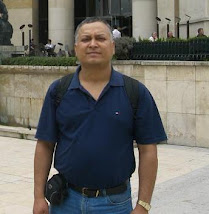10. Sunita Ranabhat / Rajesh Malla (25€)
11. Sangharsha Saksham Mishra (Hetauda, presently at Goettingen)-10€
Posted by
Krajend
at
15:43
0
comments
![]()

Posted by
Krajend
at
15:58
1 comments
![]()
Posted by
Krajend
at
06:58
0
comments
![]()
Posted by
Krajend
at
13:56
1 comments
![]()
Posted by
Krajend
at
13:29
0
comments
![]()


Posted by
Krajend
at
11:20
0
comments
![]()
Posted by
Krajend
at
11:19
0
comments
![]()
Posted by
Krajend
at
12:38
0
comments
![]()
Posted by
Krajend
at
09:35
0
comments
![]()
Posted by
Krajend
at
09:18
0
comments
![]()

Posted by
Krajend
at
08:53
0
comments
![]()
 |
| The pit for the fire sacrifice, with ideally 32 offerings to be offered in the name of each of the initiates |
 |
| Some of GöNeS (Goettingeli Nepalise Society members got chance to visit the exhibition |
Posted by
Krajend
at
16:32
1 comments
![]()
हामी जतिसुकै माथि उठौं,
हामी- by Bhupi Sherchan
जतिसुकै यताउति दगुरौं,
जतिसुकै ठुलो स्वरमा गर्जौं
तर, हामी फगत् पानीको थोपा हौं
पानीका निर्वलिया थोपा
जो सूर्यद्वारा माथि उचालिन्छौं
र बादल बन्छौं,
हावाको इशारामा यताउति दगुर्छौं
र आफूलाई गतिशील भन्ठान्छौं,
अनि एक चोटि माथि पुगेपछि
हामी आफ्नो धरतीलाई बिर्सन्छौ
र आफ्नो धरतीलाई
खोलालाई
बगरलाई उपेक्षापूर्वक
पालिएका कुकुर
झ्यालबाट गल्लीका कुकुरहरुलाई हेरेर भुलेझैँ
हामी भूक्तछौं
र आफ्नो कुकुर भुकाइलाई गर्जन भन्ठान्छौं
अनि अन्त्यमा एक दिन बर्सेर चकनाचुर हुन्छौं
र फेरि परिणत हुन्छौं पानीका थोपाहरुमा
निर्बलिया थोपाहरुमा
र कुनै इनार, खाडल वा पोखरीमा
कुहेर बिताउछौं बाँकी जीवन
टरे टरे टर्टराउने घिनलाग्दा भ्यागुताहरु पालेर,
बिष नभएका साँपहरु अँगालेर
हामी जतिसुकै माथि उठौ
जतिसुकैं यताउति दगुरौं
जतिसुकै ठुलो स्वरमा गर्जौ
तर, हामी भित्र-भित्रै खोक्रा छौं
हाम्रो उठाइको कुनै महत्व छैन,
हाम्रो दगुराइको कुनै लक्ष्य छैन,
हाम्रो गर्जनको
पानीमा फालिएको अगुल्टाको ‘छवाइयँ’ भन्दा बढी वजन छैन।
हामी बाहिरबाट जतिसुकै उच्च देखिए तापनि
भित्र-भित्र निरन्तर खिइँदै र घिस्सिँदै गइरहेका छौं
हाम्रो बाहिरको उचाइ झूटा हो,
भ्रम हो
अग्लो टाकुरामा उम्रिएका च्याउको उचाइभन्दा
यसको बढ्ता महत्व छैन
वा दुइटा अग्ला बाँस खुट्टामा बाँधेर हिँड्ने
भारतीय चटकेको उचाइभन्दा यसको बढी विशेषता छैन
अग्लो चुच्चे टोपी लगाई नाच्ने
सर्कसको जोकरको उचाइभन्दा यसको बढी विशेषता छैन
हामी बाहिरको उचाइमा रमेका छौ, लट्ठिएका छौं, फूलेका छौं
तर, हामीले आफ्नो आस्थाको द्वीपमा
निरन्तर खिइँदै र घिस्सिँदै गइरहेको कुरालाई भुलेका छौं
हीनतको सानो द्वीपमा पछारिएर
हामीले आफ्नो पूर्वस्मृति गुमाइसक्यौं
हामीले आफ्नो विगत उचाइलाई बिर्सिसक्यौं
हामीले मानिसको सामान्य उचाइलाई बिर्सिसक्यौं
हामीले मानिसको सामान्य उचाइलाई बिर्सिसक्यौं
त्यसैले जब कुनै सामान्य मानिस
कथामा वणिर्त ‘गुलिभर’ झै
आई पल्टन्छ हाम्रो आस्थाको द्वीपमा
हामी छक्क परेर उसलाई हेर्छौं
हामी उसलाई हेरेर छक्क पर्छौं
हामीलाई उसको उचाई देखेर आश्चर्य लाग्छ
हामीलाई आफ्नो पुड्काइ देखेर डर लाग्छ
र त हामी आफ्नो हीन चावनाका
सियो जत्रा स-साना हतियारहरुको उसमाथि
प्रहार गर्छौं
उसको अङ्ग-प्रत्यङ्गमा चढछौं
उफ्रन्छौं
टोक्छौं
चिमोट्छौँ
र अन्त्यमा थकित भएर तल ओर्लन्छौं
शान्त हुन्छौं
समर्पित हुन्छौं
र कुनै ठूलो चट्टानमाथि उर्लेर समुद्रको छालले
तर ओर्लेर त्यसको पाउ पखाले झैँ
हामी पुज्न थाल्दछौं त्यो साधरण मानवलाई
महान् भनेर
हामी बाहिरबाट जतिसुकै उच्च देखिए तापनि
भित्र-भित्रै निरन्तर खिइँदै गइरहेका छौं
हामी ‘लिलिपुट’ का मानव हौं।
हामी लघूमानव हौं।
हामी आफूखुशी कहिल्यै मिल्न नसक्ने
कसैले मिलाइदिनुपर्ने,
हामी आफुखुशी कहिल्यै छुट्टिन नसक्ने
कसैले छुट्टायाई दिनुपर्ने,
हामी आफू खुसी कहिल्यै अगाडि बढ्न नसक्ने
कसैले पछाडिबाट हिर्काउनुपर्ने, हिँडाउनुपर्ने
हामी रङ्ग-रोगन छुटेका,
टुटेका, फुटेका
पुरानो क्यारमबोर्डका गोटि हौं
एउटा मानोरञ्जक खेलका सामाग्री,
एउटा खेलाडीमाथि आश्रित,
आफ्नो गति हराएका
एउटा ‘स्ट्राइकर’ द्वारा सञ्चालित
हो, हामी मानिस कम र बढ्ता गोटी हौं।
हामी वीर छौं
तर बुद्धू छौं
हामी बुद्धू छौं
र त हामी वीर छौं
हामी बुद्धू नभइकन वीर कहिल्यै हुन सकेनौं
हामी महाभारतको कथामा वर्णित एकलव्य हौं
प्रत्येक पिँढीको द्रोणाचार्यले हामीलाई उपेक्षा गर्छ
इन्कार गर्छ मान्न हाम्रो योग्यतालाई,
शक्तिलाई,
र अस्तित्वलाई
तर, हामी तिनै द्रोणाचायैको मूर्ति बनाउँछौं
आफ्नो झुप्रो अगाडि,
त्यसलाई पुज्छौ
ढोग्छौं
निरन्तर धनुर्विद्याको अभ्यास गर्छौं
र द्रोणचार्यका अन्य कुलीन
चेलाहरुभन्दा बढी कुशलता प्राप्त गर्छौं
तर, हाम्रो कुशलतादेखि आर्श्चर्यचकित
र भयभीत भई
प्रत्येक पिंढीमा द्रोणाचार्य हामीकहाँ आउँछ
र गुरु-दक्षिणा माग्छ
र हामी सहर्ष उसको इशारामा
आफ्नो बुढी औंला काटेर उसलाई भेटी दिन्छौं,
आफ्नो अस्तित्व मेटेर उसलाई समर्पित गछौं
र मक्ख पछौं आफ्नो गुरुभक्तिमाथि
आफ्नो आत्मशक्तिमाथि
त्यसैले हामी वीर त छौं
तर, बुद्वू छौं
हामी बुद्वू छौ
र त हामी वीर छौं
हामी बुद्वू नभइकन वीर कहिल्यै हुन सकेनौं
हामी कसैको मूर्ति स्थापना नगरीकन
वीर कहिल्यै हुन सकेनौं
हामी पाइतला हौं
केवल पाइतला
र फगत पाइतला
पाइतलाः जसको भरमा शरीर उभिन्छ
पाइतलाः जसको आधारमा शरीर हिँडछ
पाइतलाः तर जो भन्ठान्छ कि
शरीरले कृपा गरेर उसलाई पालिरहेछ
दया गरेर उसलाई सँग-सँगै हिँडाइरहेछ
मक्ख पर्छ शरीरको महान्तामाथि
र सधैँ सम्पूर्ण शरीरको भार सहन्छ
सधै शरीरको सबभन्दा तल रहन्छ
कहिल्यै शिर उचालेर माथि हेर्दैन
सधैँ-सधैँ नतमस्तक रहन्छ
हामी पाइतला हौ
हामी दौडमा प्रथम हुन्छौं
र हाम्रो निधारले टीका थाप्छ,
हामी दौडमा प्रथम हुन्छौं
र हाम्रो घाँटीले माला लाउँछ
हामी दौडमा प्रथम हुन्छौं
हाम्रो छातिले तक्मा टाँस्छ
हाम्रो टिका थाप्ने निधार अर्कै छ
हाम्रो माला लगाउने निधार अर्कै छ।
हाम्रो ताक्मा टाँस्ने छाती अर्कै छ,
हामी त फगत कसैको इसारामा
टेक्ने, हिँडने र दगुर्ने पाइतला हौं
केवल पाइतला
र फगत पाइतला।
हामी केही पनि होइनौं
र शायद त्यसैले केही हौं कि!
हामी कतै पनि, केही पनि छैनौं
र शायद त्यसैले कतै, केही छौं कि!
हामी बाँचिरहेका छैनौं
तर शायद त्यसैले पो बाँचेका छौं कि!
त्यसैले आओ ए शून्य पूजकहरु!
हामी सब मिलेर ढोगौं यो रिक्ततालाई
हाम्रो सब मिलेर ढोगौं यो रिक्ततालाई
हाम्रो अस्तित्वको यो देवतालाई।
Posted by
highlander
at
12:43
1 comments
![]()
Posted by
Krajend
at
12:23
0
comments
![]()



Posted by
Krajend
at
20:01
2
comments
![]()




















